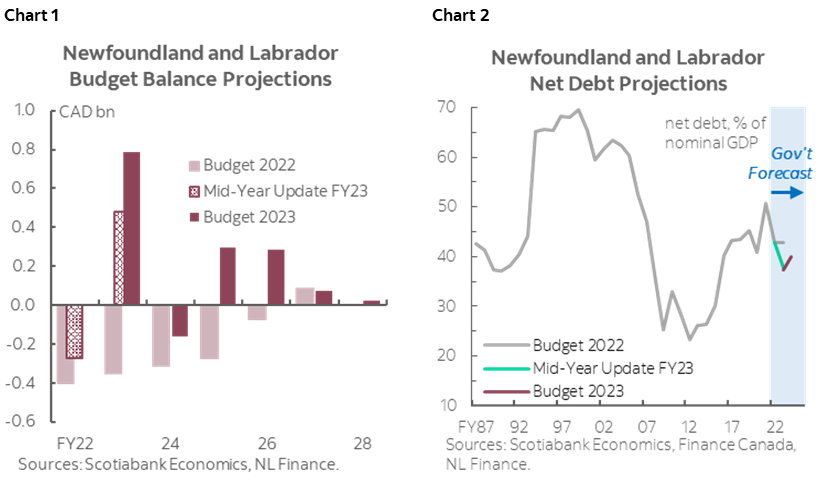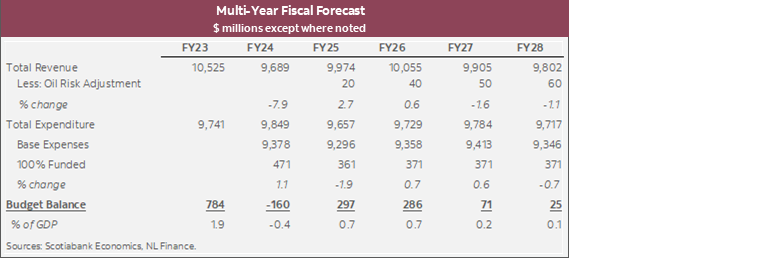NAVIGATING HOPE AND HURDLES
- Budget balance forecasts: $784 mn (1.9% of nominal GDP) in FY23, -$160 mn (-0.4%) in FY24, before a return to surplus in FY25 at $297 mn (0.7%)—two years earlier than anticipated in the previous budget; modest surplus continues at $286 mn (0.7%) in FY26, $71 mn (0.2%) in FY27, and $25 mn (0.1%) in FY28 (chart 1).
- Net debt: expected to decline to 37.3% of nominal GDP in FY23, followed by an increase to 39.9% in FY24 (chart 2).
- Real GDP growth forecast: +0.3% in 2022, +2.8% in 2023—revised down by 20 bps and 60 bps respectively since last budget. Real GDP growth is expected to pick up to 3.0% in 2024 and 3.1% in 2025.
- The province plans to deposit another $127 mn into the newly minted Future Fund this year, which will be used to pay down debt.
- Borrowings: $1.5 bn in FY24 (including $0.6 bn in debt maturities), following $1.7 bn total in FY23.
- Newfoundland and Labrador’s Budget 2023 was presented amid strong past momentum and looming uncertainties. While the budget carries good news with a balanced book in sight, the province continues to face fiscal challenges with a persistently high net debt burden and a growth path largely reliant on natural resources and major capital projects.

OUR TAKE
Newfoundland and Labrador projects a brief return to a minor deficit in FY24, equivalent to 0.4% of GDP, with a subsequent return to a balanced budget for the remainder of the forecast horizon. This follows FY23’s surprise surplus, now estimated at $784 mn (1.9% of GDP), up from the $479 mn estimated in the mid-year update due to higher revenue (+1.2%) and lower expenditure (-1.9%).
The brief return to deficit in FY24 reflects falling oil prices and production, partly offset by a jump in federal transfers ($334 mn). Total revenue is projected to see a sharp drop of -7.9%, with tax revenues expected to decrease in tandem with the -3.4% contraction forecasted for nominal GDP. Oil revenues—representing 12% of overall revenues—are expected to drop -10.3% from FY23 to $1.1 bn. Brent crude prices are forecasted to average 86 USD/bbl in FY24—around 10 USD/bbl higher than the spot price on budget day—representing some downside risks to the outlook with a $1 increase in oil prices linked to approximately $16 mm in royalties. Oil production is expected to move sideways in 2023 after a sharp drop last year, and is set to pick up by 4.7% next year. On a positive note, increased mineral production and robust capital investment (+8.1%) should give real growth a boost in 2023—the budget estimates are based on the assumptions that Newfoundland and Labrador’s economy will grow by 2.8% this year, and 3.0% next year.
Despite boosted spending in critical areas such as health care, expense control continues to underpin the path toward fiscal balance. Total spending is expected to increase only slightly by 1.1% in FY24, but with notable increases in health and community services (+6.8%) and education (+4.6%). Total expenses are projected to remain effectively flat in outer years starting in FY25 as the government keeps new investments incremental and targeted. The budget also maintains measures to support the cost of living, including the extension of the reduction on gas and diesel prices. The province also dedicates $64 mn towards increasing wages for early child educators, along with $67.1 mn for the Senior’s Benefit.
The province continues to invest heavily in capital projects. Investments in infrastructure projects are expected to total $1.1 bn in FY24, generating $479 mn in economic activity. The budget includes a significant investment of $1.4 bn investment over five years towards provincial roads and highways.
With less debt maturing, the province expects a smaller borrowing program in FY24. The province expects to borrow $1.5 bn in FY24—down from the $1.7 bn completed in FY23—of which $0.6 bn will be used to refinance maturing debt. With a deficit projected in FY24 and increased capital spending, net debt is expected to rise to 39.9% of GDP, but from a lower level in FY23 (37.3% instead of the 42.7% anticipated in the last budget)—still one of the highest among the provinces despite the improvement from last year’s forecast.

DISCLAIMER
This report has been prepared by Scotiabank Economics as a resource for the clients of Scotiabank. Opinions, estimates and projections contained herein are our own as of the date hereof and are subject to change without notice. The information and opinions contained herein have been compiled or arrived at from sources believed reliable but no representation or warranty, express or implied, is made as to their accuracy or completeness. Neither Scotiabank nor any of its officers, directors, partners, employees or affiliates accepts any liability whatsoever for any direct or consequential loss arising from any use of this report or its contents.
These reports are provided to you for informational purposes only. This report is not, and is not constructed as, an offer to sell or solicitation of any offer to buy any financial instrument, nor shall this report be construed as an opinion as to whether you should enter into any swap or trading strategy involving a swap or any other transaction. The information contained in this report is not intended to be, and does not constitute, a recommendation of a swap or trading strategy involving a swap within the meaning of U.S. Commodity Futures Trading Commission Regulation 23.434 and Appendix A thereto. This material is not intended to be individually tailored to your needs or characteristics and should not be viewed as a “call to action” or suggestion that you enter into a swap or trading strategy involving a swap or any other transaction. Scotiabank may engage in transactions in a manner inconsistent with the views discussed this report and may have positions, or be in the process of acquiring or disposing of positions, referred to in this report.
Scotiabank, its affiliates and any of their respective officers, directors and employees may from time to time take positions in currencies, act as managers, co-managers or underwriters of a public offering or act as principals or agents, deal in, own or act as market makers or advisors, brokers or commercial and/or investment bankers in relation to securities or related derivatives. As a result of these actions, Scotiabank may receive remuneration. All Scotiabank products and services are subject to the terms of applicable agreements and local regulations. Officers, directors and employees of Scotiabank and its affiliates may serve as directors of corporations.
Any securities discussed in this report may not be suitable for all investors. Scotiabank recommends that investors independently evaluate any issuer and security discussed in this report, and consult with any advisors they deem necessary prior to making any investment.
This report and all information, opinions and conclusions contained in it are protected by copyright. This information may not be reproduced without the prior express written consent of Scotiabank.
™ Trademark of The Bank of Nova Scotia. Used under license, where applicable.
Scotiabank, together with “Global Banking and Markets”, is a marketing name for the global corporate and investment banking and capital markets businesses of The Bank of Nova Scotia and certain of its affiliates in the countries where they operate, including; Scotiabank Europe plc; Scotiabank (Ireland) Designated Activity Company; Scotiabank Inverlat S.A., Institución de Banca Múltiple, Grupo Financiero Scotiabank Inverlat, Scotia Inverlat Casa de Bolsa, S.A. de C.V., Grupo Financiero Scotiabank Inverlat, Scotia Inverlat Derivados S.A. de C.V. – all members of the Scotiabank group and authorized users of the Scotiabank mark. The Bank of Nova Scotia is incorporated in Canada with limited liability and is authorised and regulated by the Office of the Superintendent of Financial Institutions Canada. The Bank of Nova Scotia is authorized by the UK Prudential Regulation Authority and is subject to regulation by the UK Financial Conduct Authority and limited regulation by the UK Prudential Regulation Authority. Details about the extent of The Bank of Nova Scotia's regulation by the UK Prudential Regulation Authority are available from us on request. Scotiabank Europe plc is authorized by the UK Prudential Regulation Authority and regulated by the UK Financial Conduct Authority and the UK Prudential Regulation Authority.
Scotiabank Inverlat, S.A., Scotia Inverlat Casa de Bolsa, S.A. de C.V, Grupo Financiero Scotiabank Inverlat, and Scotia Inverlat Derivados, S.A. de C.V., are each authorized and regulated by the Mexican financial authorities.
Not all products and services are offered in all jurisdictions. Services described are available in jurisdictions where permitted by law.

